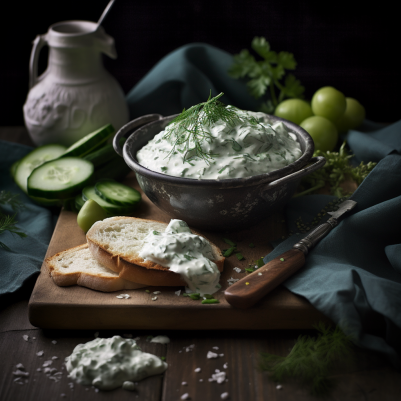Please note that some of the links on this website are affiliate links. I will earn a commission if you decide to make a purchase after clicking through the link. As an Amazon Associate I earn from qualifying purchases.
Tzatziki: A Guide to the Traditional Greek Sauce

Tzatziki is a traditional Greek sauce that has found its way into various cuisines around the world. It’s a refreshing blend of strained yogurt, cucumbers, garlic, olive oil, and herbs such as dill, mint, parsley, and thyme. This chilled sauce is a staple in Mediterranean and Middle Eastern cuisines, often served as a dip, spread, or sauce.
What is Tzatziki?
Tzatziki is a yogurt and cucumber-based sauce that originated in Southeast Europe and the Middle East. The name “tzatziki” comes from the Modern Greek word (τζατζίκι), which in turn comes from the Turkish word “cacık”. In Turkey and the Balkans, tarator means a combination of yogurt and cucumber, while in the Levant it refers to a tahini-based sauce.
The key ingredients in tzatziki are strained yogurt, cucumbers, garlic, olive oil, and herbs. The yogurt used is typically Greek yogurt, which is strained to remove excess moisture, giving the sauce its thick and creamy consistency. The cucumbers are usually grated and then drained to remove excess water. Garlic, olive oil, and herbs such as dill, mint, or parsley are then added to the mixture. The sauce is typically seasoned with salt and sometimes lemon juice or vinegar for a tangy flavor.
How is Tzatziki Made?
Making tzatziki at home is quite simple and requires only a few ingredients. Start by choosing a good quality plain Greek yogurt. Strain the yogurt to remove any excess moisture. This can be done by placing the yogurt in a cheesecloth or paper towel and allowing it to drain.
Next, grate a cucumber and sprinkle it with salt to draw out the excess water. After a few minutes, squeeze the grated cucumber to remove as much water as possible. This step is crucial as it prevents the tzatziki sauce from becoming too watery.
Finely chop some fresh dill and mince a few cloves of garlic. Measure out some lemon juice or white wine vinegar. Combine the strained yogurt, drained cucumber, dill, garlic, and lemon juice or vinegar in a bowl. Mix well until all the ingredients are well combined. The result is a creamy, flavorful sauce that’s packed with fresh flavors.
How to Serve Tzatziki?
Tzatziki is incredibly versatile and can be served in a variety of ways. It’s commonly served as a dip with pita bread or fresh vegetables. It can also be used as a sauce for sandwiches, particularly gyros and falafel. Tzatziki is also a great accompaniment to grilled meats and vegetables.
Is Tzatziki Healthy?
Tzatziki is a healthy sauce option as it’s made primarily with Greek yogurt and cucumbers. Greek yogurt is a good source of protein and probiotics, which are beneficial for gut health. Cucumbers are low in calories and contain a good amount of water and soluble fiber, making them ideal for weight loss and hydration. The garlic and herbs used in tzatziki also have various health benefits.
Frequently Asked Questions About Tzatziki
What do you eat tzatziki dip with? Tzatziki is versatile and can be served with pita and veggies, chicken shawarma, homemade falafel or gyro sandwich, grilled vegetables, etc.
How is tzatziki healthy? Tzatziki is made mostly with Greek yogurt and cucumber making it light on calories. Greek yogurt is a good source of protein and probiotics, and cucumbers are low in calories andcontain a good amount of water and soluble fiber.
How do you pronounce tzatziki Greek? Tzatziki is pronounced as “tsah-see-key”.
Is tzatziki better for you than sour cream? Yes, tzatziki is generally healthier than sour cream. It’s made with Greek yogurt, which is high in protein and lower in fat than sour cream.
Can tzatziki be used as a salad dressing? Yes, tzatziki can be used as a salad dressing. It’s especially good on Greek salads or any salad with Mediterranean flavors.
How long does homemade tzatziki last? Homemade tzatziki can be stored in an airtight container in the fridge for up to a week.
Can you freeze tzatziki? It’s not recommended to freeze tzatziki as it can cause the yogurt to separate and the sauce to become watery when thawed.
Is tzatziki vegan? Traditional tzatziki is not vegan as it’s made with Greek yogurt. However, you can make a vegan version using plant-based yogurt.
What’s the difference between tzatziki and raita? While both tzatziki and raita are yogurt-based sauces, they originate from different cuisines. Tzatziki is Greek and uses dill, while raita is Indian and often uses cumin and other Indian spices.
Can tzatziki be heated? Tzatziki is typically served cold or at room temperature. Heating it may cause the yogurt to separate and the sauce to become watery.
Tzatziki Sauce FAQ
Q1: What is Tzatziki sauce?
A: Tzatziki is a traditional Greek sauce made from yogurt, cucumber, garlic, and herbs like dill and mint.
Q2: What does Tzatziki taste like?
A: Tzatziki has a fresh, tangy, and slightly garlicky flavor with a hint of cucumber and herbs.
Q3: What is Tzatziki sauce used for?
A: Tzatziki sauce is used as a dip for pita bread, a topping for gyros, or a sauce for grilled meats and vegetables.
Q4: Can I use low-fat yogurt for Tzatziki?
A: Yes, but full-fat yogurt is traditionally used and gives a creamier texture.
Q5: Can I use dried herbs instead of fresh?
A: Fresh herbs are preferred for their flavor, but dried herbs can be used in a pinch.
Q6: How long does homemade Tzatziki last?
A: Homemade Tzatziki can last up to a week in the refrigerator.
Q7: Why is my Tzatziki watery?
A: This can happen if the cucumber isn’t properly drained. Make sure to squeeze out as much water as possible.
Q8: Can I freeze Tzatziki sauce?
A: It’s not recommended as the yogurt can separate and become grainy when thawed.
Q9: Is Tzatziki sauce healthy?
A: Yes, it’s made with healthy ingredients like yogurt, cucumber, and garlic.
Q10: Can I use Tzatziki as a salad dressing?
A: Yes, it’s a great dressing for Greek salads.
Q11: Can I use lime juice instead of lemon?
A: Lemon is traditional, but lime can be used for a different flavor.
Q12: Can I make Tzatziki without garlic?
A: Garlic is a key flavor, but it can be omitted if you’re not a fan.
Q13: Can I use regular cucumber instead of English cucumber?
A: Yes, but English cucumber is preferred for its thin skin and fewer seeds.
Q14: Can I use sour cream instead of yogurt?
A: Yes, but the flavor and texture will be slightly different.
Q15: Is Tzatziki sauce vegan?
A: Traditional Tzatziki is not vegan as it contains yogurt, but it can be made vegan by using plant-based yogurt.
Q16: Can I add other ingredients to my Tzatziki?
A: Yes, some people add ingredients like red wine vinegar, parsley, or even feta cheese.
Q17: Is Tzatziki sauce gluten-free?
A: Yes, Tzatziki is naturally gluten-free.
Q18: Can I use Tzatziki as a marinade?
A: Yes, it’s great as a marinade for chicken or lamb.
Q19: What can I substitute for dill in Tzatziki?
A: Mint is a common substitute for dill in Tzatziki.
Q20: Can I use bottled lemon juice?
A: Fresh lemon juice is best, but bottled can be used if necessary.
Q21: Can I make Tzatziki without cucumber?
A: Cucumber is a key ingredient, but you can make a version without it if you prefer.
Q22: Can I use Tzatziki on a burger?
A: Yes, Tzatziki makes a great topping for burgers, especially lamb or chicken burgers.
Q23: Is Tzatziki sauce spicy?
A: No, Tzatziki is not typically spicy. It has a fresh, tangy flavor.
Q24: Can I use Tzatziki in a wrap or sandwich?
A: Yes, Tzatziki is delicious in wraps and sandwiches, especially with grilled chicken or vegetables.
Q25: Can I use Tzatziki as a pasta sauce?
A: Yes, Tzatziki can be used as a light, refreshing pasta sauce.
Q26: Can I make Tzatziki with regular yogurt?
A: Yes, but Greek yogurt is preferred for its thickness and tangy flavor.
Q27: Can I use Tzatziki as a dip for chips?
A: Yes, Tzatziki is a great dip for chips or crudites.












